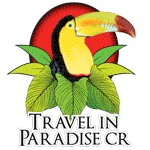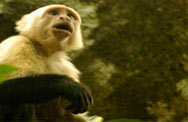|
|
Manuel Antonio National Park :
With a mere 682 ha. of land area, Manuel Antonio is one of the smallest of Costa Rica's national parks. However, with its idyllic beaches, excellent wildlife viewing opportunities, relative ease of access, and good surrounding infrastructure, this is one of the country's most visited parks.
Part of the park's scenic beauty is provided by Cathedral Point, a 72 meter-high point of land that is covered by rain forest. The point was formerly an island just off the mainland, but ocean currents caused the deposition of sand between the two until eventually they were connected, forming a geological feature known as a tombolo. The park's two most frequented beaches, Manuel Antonio and Espadilla Sur, are the sandy arcs on either side of the narrow strip of land that joins Cathedral Point with the mainland.
Due to the diminutive size of the park and the quantity of visitors it receives, much of the wildlife that can still be found here is quite accustomed to human presence and will allow close approach, particularly the White-throated Capuchin Monkeys, Central American Squirrel Monkeys, Brown-throated Three-toed Sloths, White-nosed Coatis, Central American Agoutis and Ctenosaur Lizards. [Note: These are still wild animals and should be respected and treated as such, enjoy the opportunity for a close look, but do not attempt to touch or feed them!]
This is one of the best places in Costa Rica to see Brown-throated Three-toed Sloths. These fascinating, but slow-moving animals feed exclusively on plant material -- the low-energy diet results in their slow metabolism -- and though they are known to eat the leaves of more than 100 species of trees and vines, they are most easily seen when feeding (or resting) in Cecropia trees.
Cecropias are common pioneer trees with large palmate leaves and ringed trunks that make them easy to recognize. The abundance of cecropias and other second growth species in the park is probably in part responsible for the high sloth population.
This is also one of only two areas in the country where the endangered Central American Squirrel Monkey is found. These are the smallest of the four monkey species in Costa Rica, and the only ones without a prehensile tail. They forage actively for insects and fruit in large groups of 30 or more individuals.
Butterflies, birds, and large colorful land crabs are more of the plentiful inhabitants that provide interest during a trail walk through the park. And, if the waters are clear enough, a variety of marine life can be seen by snorkeling around the rocky ends of either beach.
Getting there: Manuel Antonio is approximately four hours from San José by car, taking the PanAmerican Highway west to the Atenas exit, and following the old highway through the mountains to the town of Orotina where you rejoin a more modern highway. Take the Jacó turnoff and follow this coastal highway south to the town of Quepos. From here it's 7 km. to Manuel Antonio. There is regular public bus service to/from San José, but tickets should be purchased in advance, especially during peak tourism periods (from December through March and on weekends).
Flying on the local commercial airlines is another alternative. The flight takes about 18 minutes and the airstrip is about 20 minutes from Manuel Antonio.
The park itself is entered by crossing a small estuary near where it empties into the ocean. At low tide, this rivulet is usually no more than ankle-deep, but at extreme high tides it can be as much as a meter and a half deep! Either time your coming and going accordingly, or be prepared to get wet.
Fishing: The Quepos area is the center for sportfishing in the Central Pacific region of Costa Rica with several charter services operating here. Most anglers are going for billfish which provide plenty of action throughout the year, but especially from December through April. Tuna, dorado, and roosterfish are other reliable alternatives when not seeking sailfish and marlin.
Climate: Though hot and humid throughout the year, the shade produced by the evergreen vegetation and the gentle sea breezes help to ameliorate the heat. The dry season extends from December to April, nearly 4 meters of rainfall is the average accumulation during the remaining months of the year.
History: The creation of Manuel Antonio National Park was another victory for conservation. Although the area had been in private hands for some time, the public had always been allowed to use the beaches. However, when the property was bought by a North American in 1968, things changed. Padlocked gates and fences were put up to keep people out, leading to great discontent among the local inhabitants, who reacted with acts of vandalism.
The local municipal government decreed that access to the beach could not be restricted (this is actually a nationwide law), and the American ended up selling the land to a Frenchman. This new owner apparently had plans to develop the site into a tourism facility, but before he could do so, the land was expropriated by the government and in November of 1972, Manuel Antonio National Park was officially declared, even though the funds to pay for the land acquisition were not completely obtained until 1975.
Ironically, since the mid-1980's, the park service has maintained a locked gate policy on the service road entrance to the park. This one-lane wide gravel road, known as the Perezoso Trail for its abundance of Three-toed Sloths, is a wonderful place for nature observation without having to cross through the estuary by the main entrance -- if only you were allowed to go in this way.
|
Travel Tips:
FAQs: You might be wondering too.
About CR
About weather
What to pack: click here to get ideas on what you really need to bring along.
What to wear: click here to get ideas on what to wear. Avoid mistaken clothes.
Our Specialty Your Best Travel, vacations Family Trips, Honeymoons, Educational Trip, Escorted Trip.
Honeymoon Beyond a romantic setting, a honeymoon in Paradise is a magical experience.
Family oriented Trip
: Is about experiencing fascinating cultures, family adventures, family tours, quality time together.
Incentives travels: Creative ideas, consulting services for a theme party or special event.
|










